|
Index...
|
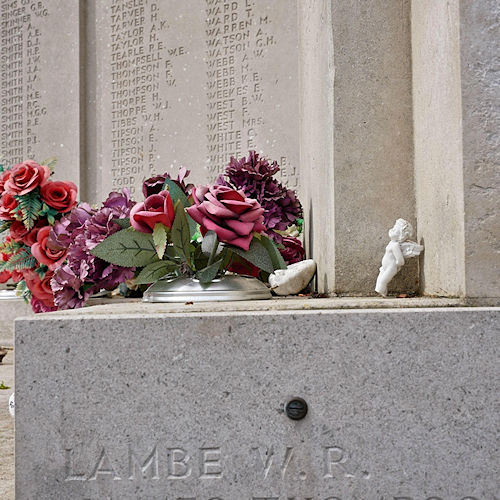
 he memorial on the right appeared in the Coventry Evening Telegraph on Wednesday 19th November 1941. It was a tribute to William Robert Lambe, a Belfast born hero of the Coventry Blitz which took place on 14th/15th November 1940. Known in the city as Billy, he was on duty that night as a Police Special Constable. At Jordan Well, not far from the Gaumont Cinema, the Smiths (home furnishings) and Decorwall (decorating supplies) stores had taken a direct hit. Below them, in a large medieval cellar that was being used as an air raid shelter, a number of civilians were trapped. A small band of Police - Regulars and Specials - were attempting to remove rubble and debris to free them. His colleague in the Specials, Harry Berry, was stripped to his waist and Billy himself was wearing a short sleeved shirt such was the heat from burning buildings nearby and the exhausting nature of the task in hand. They were joined by P.C. Kenneth Rollins. The blazing fires and bombs falling all around did not deter the rescue party who fearlessly and courageously went about their work. Sadly, another bomb landed in the same place and the rescuers and those who were trapped were all killed.
he memorial on the right appeared in the Coventry Evening Telegraph on Wednesday 19th November 1941. It was a tribute to William Robert Lambe, a Belfast born hero of the Coventry Blitz which took place on 14th/15th November 1940. Known in the city as Billy, he was on duty that night as a Police Special Constable. At Jordan Well, not far from the Gaumont Cinema, the Smiths (home furnishings) and Decorwall (decorating supplies) stores had taken a direct hit. Below them, in a large medieval cellar that was being used as an air raid shelter, a number of civilians were trapped. A small band of Police - Regulars and Specials - were attempting to remove rubble and debris to free them. His colleague in the Specials, Harry Berry, was stripped to his waist and Billy himself was wearing a short sleeved shirt such was the heat from burning buildings nearby and the exhausting nature of the task in hand. They were joined by P.C. Kenneth Rollins. The blazing fires and bombs falling all around did not deter the rescue party who fearlessly and courageously went about their work. Sadly, another bomb landed in the same place and the rescuers and those who were trapped were all killed.
Brown-haired Billy was just 26 years old when he died. He was among 172 victims of the ferocious Nazi air raid buried in a communal war grave at London Road Cemetery on 20th November. He left behind a wife and four year old daughter. In this article I will attempt to piece together fragments of his life; his family background in Belfast, a look at the unique story of the building that served as Heath Road Methodist Church when he worshipped there, and the major role that he played in the formation of the 3rd Coventry (Heath Road Methodist Church) Company of the Boys' Brigade.
William Robert Lambe was born on 16th June 1914 at 23 Tasmania Street. This was a little street in the famous Shankill district that ran from the Crumlin Road to Queensland Street. Tasmania Street and Queensland Street no longer exist, and on a modern map, Tudor Grove, which runs from Tudor Place to Snugville Street is roughly where they were located. I have little information on his upbringing and life in Belfast, but a look at his parents helps to give some insight into who and what moulded him into the man he became.
He was the first born son of Robert Lambe and Jane Campbell Lambe (nee Wilson). Both of his parents came from working class Methodist families. Robert, who was a teetotaller, was born on 16th December 1892 at 29 Bann Street, which was at the Crumlin Road end of the Oldpark Road and not far from Tasmania Street - and like that street, it no longer exists; there is a nod to it in the general area where it once stood through the name of Bann Court which is off Shannon Street.
In the 1911 census, Robert was the eldest of six children living with his parents at 6 Urney Street. His profession was recorded as a Grocer's Assistant. Urney Street ran from the Shankill Road down towards the Clonard District. His home was at the Shankill Road end of it and was not too far away from the Shankill Methodist Church. Urney Street has disappeared too - on a modern map his house would have been in the area where the poignant Shankill Memorial Garden is now. His father was also called Robert and was a Stone Cutter. His mother was known as Lizzie and her maiden name was Halliday.
Jane, who was known as Jean, was born on 12th July 1893 at 110 Silvio Street in the heart of the Shankill. Her father was William Hugh Wilson and her mother was called Ellen Wilson (nee Mercer). William was a Commercial Traveller. Jean had two sisters. In the 1911 census, the family was living at 29 Ambleside Street along with two relatives from the Mercer family. Jean's profession was recorded as a Hand at a linen factory.
Billy's parents came into adulthood at the time of the Home Rule crisis (1912-1914) and this clearly had a big impact on them at that time. Both of them signed Ulster's Solemn League and Covenant - Robert at St. Mary's Church Institute on Crumlin Road and Jean signed the Women's Declaration at the Shankill Road Orange Hall. The signatories pledged to resist the implementation of Home Rule for Ireland by any means necessary.
On 3rd January 1913, the Shankill Road Primitive Methodist Church Total Abstinence Loyal Orange Lodge No. 465 held a reunion and concert at the West Belfast Orange Hall. Robert Lambe was recorded as the secretary of the Lodge, which was founded around 1902, and Miss J. Wilson was among the ladies who helped serve tea at the event, which included entertainment, games and speeches about the Home Rule crisis.
Robert and Jean were married later that year on 19th August 1913 at University Road Methodist Church by the Rev. John James Daly. Although their wedding took place in South Belfast, the Shankill Road Methodist Church was their regular place of worship. Reverend Daly was the local circuit preacher for the area, which also included the Agnes Street, Falls Road and Woodvale Methodist Churches. At the time of the wedding, 21 year old Robert was still a Grocer's Assistant and resided at 23 Eccles Street. Jean, who was 20, resided at 12 Acton Street. No profession was recorded for her.
The Lambe's would have a long association with the Shankill Road Methodist Church. Robert served in various lay roles including that of Senior Steward and being an Inspector of the Sunday School. Both he and his wife were instrumental in organising fund raising events and the like for their place of worship. In 1921, Robert was one of the signatories to a letter from the Church that appeared in newspapers appealing for clothes from the public and shops. Belfast was suffering from high unemployment at this time and these were to be distributed to those in the area around the Church who were most in need.
Robert also served in various leadership roles with his Orange lodge, which was noted for its fundraising efforts for various charities such as the Lord Enniskillen Memorial Orphan Fund. He also served for ten years as the District Master for Belfast No.8 district of the Loyal Orange Institution of Ireland - and again, during his tenure, No. 8 district was noted for its fundraising efforts for various good causes. The Belfast Orange Hall in Clifton Street would have felt like a second home to him as he spent a lot of his spare time there.
He was also a member of the Young Citizens' Total Abstinence Royal Black Preceptory No. 587. This suggests that he had been a member of the Young Citizen Volunteers. The Y.C.V. was first suggested in letters to a number of Belfast newspapers in May 1912 by Mr. F. T. Geddes. His aim was for a non-sectarian and non-political follow-on organisation to the Boys' Brigade and Scouts organisations for 18-25 year old men. As well as encouraging civic responsibility and a sense of duty, it would also help the young men develop a manly physique through taking part in modified Police and military drills, swimming, gymnastics etc. The suggestion was well received and by September, with the support of the Lord Mayor of Belfast, Robert James McMordie, Mr. Geddes' dream became reality.
In 1914, the Y.C.V. was absorbed into the Ulster Volunteer Force, the armed militia that Irish Unionists had formed in opposition to Home Rule. When World War One broke out, the issue of Home Rule was put on hold. The 36th Ulster Division was formed specifically to absorb members of the U.V.F. into the ranks of the army. The men of the 36th Division fought gallantly in many of the major battles of the war and earned everlasting fame for their heroism on 1st July 1916 at the Battle of the Somme. Newspaper reports suggest that the entire membership of L.O.L. 465 had joined the U.V.F. during the Home Rule crisis with many of their wives and girlfriends joining its Nursing Corps. During the war, 22 members of the Lodge served under the colours and 5 made the supreme sacrifice.
On 21st April 1920 Billy's brother John was born. By this time the family was living at 1 Roe Street and Robert was an Insurance Agent for the Scottish Legal Assurance Company. He would work for them for the rest of his life and progress to the position of Inspector. Newspaper reports suggest that what Robert didn't know about the insurance business wasn't worth knowing and he was highly regarded in this profession.
Robert and Jean both helped organise Unionist Associations in the Shankill district and Robert would serve as the Unionist Party representative for Clifton Ward on Belfast Corporation (Belfast City Council) from 1927-1937. While on the Council he took a particular interest in the welfare of blind people and the development of Belfast Zoo and pleasure gardens at Bellevue. He served on many committees, notably the one that oversaw the city's tramways and bus service. This saw him form a strong connection with the Daimler Company of Coventry, which had a number of contracts with the Belfast Corporation. He visited Coventry a number of times on fact-finding missions and also helped entertain Daimler representatives when they visited Belfast.
At some point in the mid to latter 1920s, the family moved to 38 Thorndale Avenue off the Antrim Road. They later moved to 3 Somerdale Park off the Crumlin Road.
From humble beginnings, Billy's father, ably supported by his wife, worked hard and bettered himself. He clearly had organisational and leadership skills. Both parents had a keen sense of duty, Christian values such as helping others, and of course loyalty to their country. They also wanted their children to have a better start in life than they had had.
It is safe to assume that as well as being raised a Methodist in an alcohol free household, Billy would have been a member of the Boys' Brigade and/or similar organisations. He would have attended Sunday School too. In 1928, aged 14, he was enrolled at the prestigious Methodist College Belfast, known locally as Methody. From the notices published after his passing, we know he followed in his father's footsteps and was a member of Loyal Orange Lodge No. 465.
Billy was married to Sarah Boal at the Shankill Road Methodist Church on 26th October 1935 by the Reverend Robert Good. Sarah, who was known as Sadie, was born on 22nd September 1913 at Fern Glen, Ballygomartin Road, Belfast. Her parents were John and Sarah Jane Boal (nee Thompson.) John was deceased at the time of the wedding. She was 22 years old and Billy was 21. His profession was recorded as Motor Mechanic on the marriage certificate. He lived at his parent's home at Thorndale Avenue and Sadie lived at 56 Wheatfield Crescent. His witness was James Bamford and her witness was Elizabeth Boal.
The newlyweds moved to Coventry, and in May 1936, their daughter Jane was born at 34 Ranby Road. Like her paternal grandmother, she would be known as Jean. Ranby Road is a stone's throw away from Heath Road where there was a Methodist Church. Like the Church where they were married, it was originally part of the Primitive Methodist tradition. It was erected in 1920 as an outreach mission by the "mother" Church at Ford Street. Until this time Primitive Methodists in the area had worshipped at Milton Street.
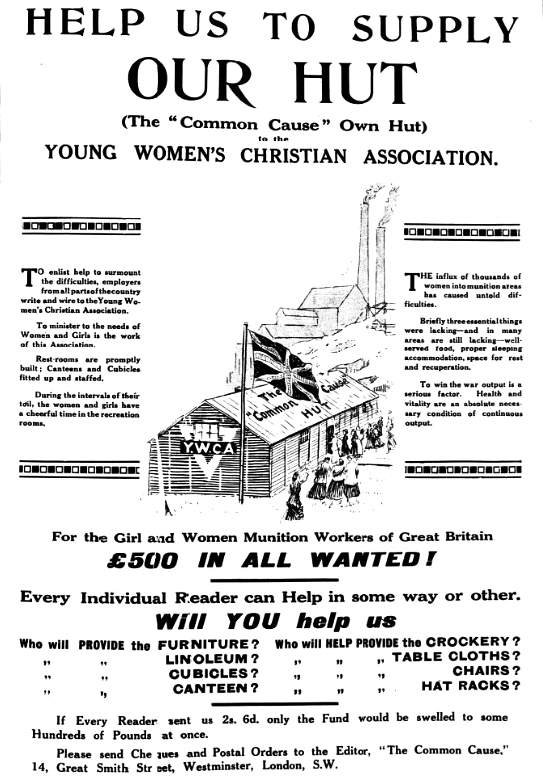
The Church at Heath Road was a large wooden building with a fascinating backstory. It started life as the Young Women's Christian Association's "Common Cause" Recreation Hut for female munitions workers in World War One. On 3rd November 1916, through their newspaper The Common Cause, the National Union of Women's Suffrage Societies launched an appeal to raise £500 to build and furnish a recreation hut for munitionettes in Coventry. This was then increased to £1,000 after the Minister of Munitions asked for the proposed building to be made larger. The fundraising was successful, with the final £30 being collected by the Coventry Women's Suffrage Society.
The original advert for the Common Cause Hut.
It was built on land at Park Road, not too far from the railway station. The land was donated by local newspaper proprietor William Isaac Iliffe, who was a major benefactor of both the Coventry Y.W.C.A. and Y.M.C.A, but it was only to be used for this purpose for the duration of the war. It opened on 4th June 1917 and was formally handed over to the Y.W.C.A. to be a place for entertainment, relaxation and learning for the countless 'Canary Girls' that were sent to Coventry from all parts of the United Kingdom - including many from Belfast and other parts of Ireland.
The hut also included some emergency sleeping cubicles for ladies who arrived on late night trains and therefore could not arrange accommodation at such short notice. The Y.W.C.A. headquarters (Sherbourne House) and hostel were not too far away at the Butts, and at the railway station itself the Y.W.C.A. had a reception hut that served refreshments and gave advice to new arrivals to the city.
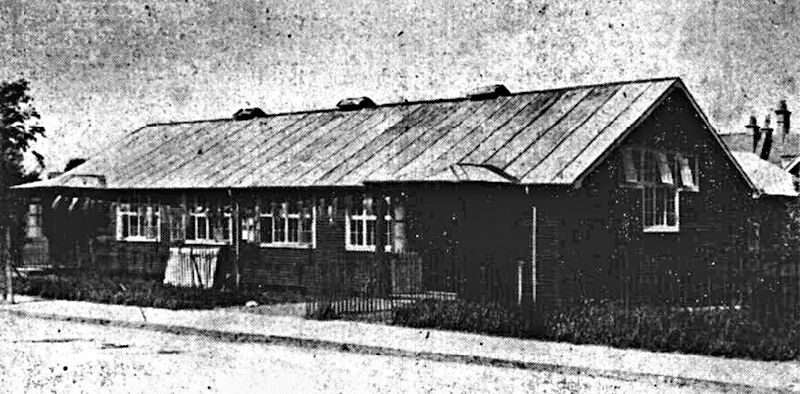
On Tuesday 18th September 1917, Queen Mary and Princess Mary visited various munition works and institutions connected with the welfare of their employees. This included the Common Cause hut in Park Road. Fundraising to buy land and build a new Church at Heath Road also began in 1917. In 1919, with the war over, the Y.W.C.A. were faced with having to remove the hut from Park Road. They set up a removal fund and explored relocating it at the Butts, but ultimately this came to nothing and in April 1920, it was put on the market with a newspaper advert detailing what was on offer:
It is hard to pinpoint exactly when it was re-erected, repurposed and opened at Heath Road in 1920 - to date, and surprisingly, I have been unable to find any reports in local newspapers - but the Milton Street Church was put up for sale in early September; Heath Road Primitive Methodist Church had a football team playing in the Coventry Bible League in October ; and the Sunday School at Heath Road opened in mid-November so presumably it must have been some time in September or October. The cost at the time for the land and building was £2,000.
In 1937, efforts to raise £4,500 for the building of a new Church of a more permanent nature began. The hut was too small and no longer considered fit for purpose as a place of worship, but was to be retained as the Church hall with the new Church built alongside it.
1937 was also the year that the 10th Coventry (Ford Street Methodist Church) Company of the Boys' Brigade was formed in conjunction with Heath Road Methodist Church. This was at the suggestion of Billy Lambe, the Captain of the B.B. at Heath Road who at that stage only had 5 members. They were combined to obtain the minimum number of boys (30) to be officially registered as a Company. Having obtained the registration, they then split it into two and shared it, with Heath Road becoming the 3rd Coventry Company.
By May 1938, Captain Lambe had raised the membership to 40 at Heath Road and spoke of his plans to have a recruiting drive to get even more boys involved. He said he also wanted all year round evening activities rather than these stopping from May until winter which was then normal practice for the B.B. An "Intelligence class" had already been set up which was a discussion group, and with the approval of the Minister of Transport, a Highway Code class was also started.

May was a busy month - 21 members of the Company took part in short 15 minute performances of physical training exercises and drills at the Forum Cinema at Walsgrave Road. These took place between the screenings of films on Monday 15th, Tuesday 16th and Wednesday 17th, and were seen by around 4,000 people.
The performances helped generate a lot of interest for the first display of the Company which was held on Thursday 18th May at Heath Road. The inspecting officer was Captain Sidney Alfred Freeman from the 1st Coventry Company, which he had founded in 1917 at St. Michael's Baptist Church. This was the first ever B.B. Company to be established in the city.
Captain Freeman, who worked for the Daimler Company, complimented the progress that had been made in such a short time and praised the smartness and discipline of the company. He was also pleased that camping trips had been planned. A guest at the display was Mr. Syd Smith, who was the assistant Scoutmaster of the 38th (Warwick Road) Boy Scout Troop. He lived near Heath Road Church and Billy invited him to not only represent the Scouts but to talk to him about some other ideas he had about bringing youth organisations in Coventry closer together. In his opinion they were all working towards the same end so it made sense to cooperate and have joint activities.
In early June more plans for evening and weekend activities were revealed. These included swimming, cricket, boxing, gymnastics and regular outdoor camps. A vice-president of the Company, Mr. W. R. MacFarlane, who was a keen model-builder, intended to pass on his skills through a model-building club, and Captain Lambe was also looking into creating a reading room for the boys with donated magazines available for them to peruse. A recruiting evening took place on Friday 3rd June.
On Saturday 11th June at Spencer Park in Earlsdon, 3rd Company took on the 38th (Warwick Road) Scout Troop at Cricket. The match ended in a draw with both teams scoring 38 runs each. It was followed by a game of touch and run. This came about as a result of discussions that Billy had with Syd Smith the previous month. The players were featured in a photograph in the Midland Daily Telegraph, which was taken prior to the contest outside Warwick Road Church.
On Saturday 9th July, the 3rd Coventry Company held a route march in Stoke, which was headed by the bugle band of the 4th Company. This was part of the above mentioned recruiting drive and leaflets were handed out to people on the streets as it passed by. Later that month, the Coventry Companies of the B.B. including 3rd Company attended divine service at Broad Street Baptist Church. The service was conducted by Rev. H. Sloan, Chaplain to the 4th Company, whose band again led the parade.
At Frederick Bird School on Saturday 16th July, the recruiting drive continued with an open air display where 3rd Company was joined by 6th Company (Harefield Road) and 10th Company (Ford Street). The plan was for it to take place on the playing field, but heavy rain disrupted proceedings, and it was moved to the playground, where a shorter display of "physical culture" training took place. Billy had been quoted in the local newspaper as saying: "You see scores of boys playing about the streets in the Stoke district during the summer evenings, with nothing in particular to do. I'd like to see them all in the Boys' Brigade, but what can be done when the Brigade shuts up shop for the summer? Anyway, I'd like to see my present strength of 42 swelled to 70 before September."
In August, 120 members of the B.B. in Coventry camped at Mundesley-on-Sea, Norfolk, and were praised by the local Postmaster who said they were a "splendid lot of boys" with good manners.
A successful city wide recruiting drive took place in September, no doubt prompted by Billy's efforts with the Heath Road Company, and the Coventry Battalion of the B.B. was inaugurated, comprising 9 Companies with a combined strength of around 400 boys. The Battalion held its first Church parade on Sunday 16th October. The service took place at Foleshill Baptist Church. About 300 officers and boys took part and the Companies were 1st (St. Michael's Baptist), 3rd (Heath Road Methodist), 4th (Foleshill Baptist), 4th A (Radford Congregational), 5th (Bell Green Methodist), 6th (Stoke Congregational), 7th (Lime Tree Park Methodist) and 9th (Radford Baptist).
In early December 1938, a sketch called "The Rookies" was a feature of the second annual display of the 3rd Coventry Company. It showed how boys were admitted and trained in the B.B. Ambulance drill, company drill and musical entertainment by Private Elliott were also included in the programme of events. Pte. Elliott played solos on the cornet, violin and xylophone. Captain Lambe and Lieutenants Mason, Nichols and Roach were complimented on the improvements during the past year by Mr. C. Ballard, the chairman. On Wednesday 28th December, in the afternoon, a party of 17 members of 3rd Coy. were given a tour of the works of the Midland Daily Telegraph newspaper. A photo of them was published in the same newspaper the following day.
In 1939, there were not so many mentions of the Heath Road B.B. In February, Billy was attempting to persuade the various youth organisations in the city to put on a combined gang show. They travelled to Kenilworth on Sunday 30th April where the Coventry Battalion took part in a Church parade. On Thursday 18th May they held another display in the Heath Road schoolroom. By this time it was one of the largest B.B. Companies in Coventry. The guest of honour was the Mayor of Coventry, Alderman Sidney Stringer. "It has taken politicians many years to find out how necessary to the nation is youth," he said during his speech. He complimented the Company on the work they had done in the past year, praised Captain Lambe for showing such a keen interest in the city's young people and added;
"Every city should be proud to possess organisations like the Boys' Brigade, whose main work in life was the welfare of the boys under its control. It had the value of comradeship and service, and as the boys got older they would find that in service would lie the greatest joy they would achieve."
The Coventry Battalion of the B.B. camped at Mundesley-on-Sea again from June 24th to 3rd July.
On 25th August, a no-warning bomb planted by the I.R.A. exploded in the heart of the city killing 5 people and injuring many more. In its aftermath, there were calls for Coventry City Council to do more to ensure the safety of the public. Some people wanted vigilante style groups to be set up. In response, the Lord Mayor suggested that people consider becoming Police Special Constables. That year, with conflict in Europe looming on the horizon, there was an ongoing recruitment drive aiming to bring the strength of Coventry's Special Constabulary up to 1,000. Just over a week later, on 3rd September, Great Britain declared war on Germany. This is when Billy is believed to have become a Special Constable. He probably signed up because of the outbreak of war, but the I.R.A. outrage may have played a part too.
During the morning and afternoon of Sunday 10th September, 320 Specials were sworn in at St. Mary's Hall in the presence of the Lord Mayor, Alderman Sidney Stringer, Coventry Police Chief Constable Stanley Albert Hector and the Commandant of the Coventry Special Constabulary, Mr. Arthur Frederick Matts. With these new recruits the target of 1,000 Specials was met.
At this time Billy was working as a fitter for the Daimler Company, which was a reserved occupation. This meant he was exempt from conscription to the armed services as he was engaged in vital war work. When war was declared, Daimler switched to wartime production. Their No. 1 factory was in the Radford area and their No. 2 Shadow factory was at Browns Lane, Allesley. At the time, he and his family were living at 2 Wycliffe Grove, Wyken. Given his father's connections with Daimler, it is possible that he had a job lined up with them on arrival in Coventry but we will probably never know. As a motor mechanic, he would have found employment easy to come by regardless.
What was described as the annual parade of the Battalion took place on Sunday 19th November. Some 250 officers and boys took part, including 3rd Heath Road Methodist. They marched from Pool Meadow to St. Michael's Baptist Church, where the Chaplain of the 1st Company, Rev. J. Minty, conducted the service.
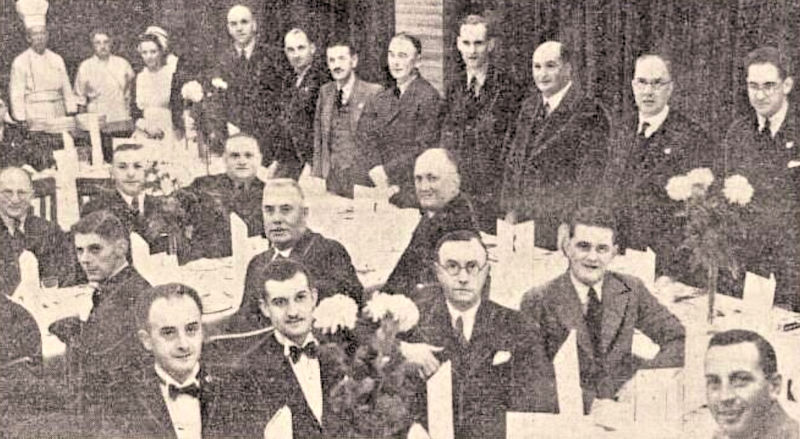
In January 1940 the leadership of the B.B. in Coventry met to allocate gymnasium equipment to the various Companies and also approved grants for the purchase of games equipment. On Sunday 3rd March, the Coventry Battalion marched from Pool Meadow to Heath Road Church where the Chaplain of 3rd Company, Rev. Graham Titterington conducted the service. This is the last mention of Heath Road or 3rd Company that I was able to find in 1940. This possibly indicates that Billy had less time to devote to it due to his war work at Daimler and increased duties as a Special Constable.
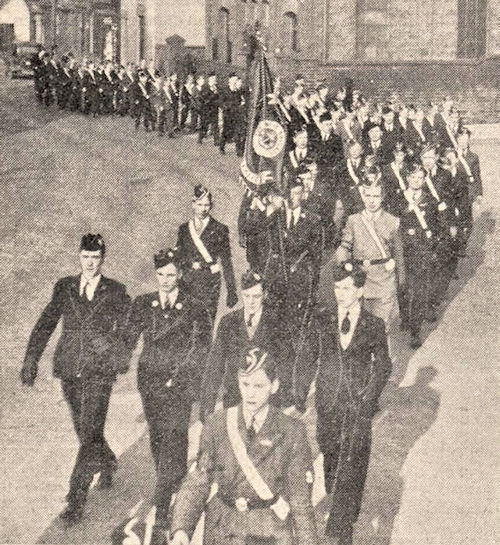
On Sunday 28th July, over 500 members of the Special Constabulary held a parade on Pool Meadow, which included two divisions of the patrol section, two divisions of the mobile section, telephone communication section, siren point section and the arms section. The mobile sections were accompanied by 140 vehicles. Also that month, A & B Divisions of the Mobile Patrol Sections donated £16 15 shillings (about £775 in 2025 money) to the Coventry Fighter (Plane) Fund.
In August, the B.B. was recruiting again. A newspaper article stated:
"An important part of the duties undertaken by the Captain is to do his utmost to find suitable employment for members of the brigade, who are encouraged to develop their individual interests and seek work best fitted to their ability instead of joining the ranks of "misfits" in civil occupations.
Candid talks with the boys and co-operation with the parents assist materially (with) this ever-present problem which faces modern youth."
In early October 1940, Heath Road Methodist Church was reopened after improvements and renovations were made to it. The plans for a brand new Church were put on hold because of the War. Permanent foundations were laid under the walls of the existing building and new flooring was installed. October also saw the start of frequent air raids on Coventry. Although they were nothing like what was to come on November 14th/15th, lives were lost and damage was caused. In an attack on 12th October, John and Elizabeth Maguire were killed. They too had moved to Coventry from Belfast, having latterly lived in the Falls Road area. John, who was known as Jack, had won £600 in the Irish Hospitals Sweepstake in November 1931 - in 2025, this would be around £30,000. Elizabeth was known as Lily. Her maiden name was Laverty and she was a niece of the famous Belfast Celtic F.C. full-back Harry Laverty. Their home at 58 Aldbourne Road, Radford, was in the flight path for bombers targeting the nearby Daimler works. They were buried in London Road Cemetery on 17th October following Requiem Mass at St. Osburg's Church. One small crumb of comfort was that they had evacuated their young son Patrick back to Belfast a few months prior to the raid.
Sadie and young Jean Lambe had also returned to Belfast where they stayed with Billy's parents, who were now living at 3 Somerdale Park. Belfast was considered a much safer option at this stage of the war and following the November Blitz, people from Coventry (and indeed other heavily bombed cities in Great Britain) were evacuated to there and other parts of Northern Ireland. The notion that Belfast was safe from enemy raids was to be proved catastrophically wrong. It was heavily bombed in April and May of 1941 which sadly resulted in huge loss of life and massive damage. Some evacuees from Coventry were caught up in these raids.
There is little more to add to what happened to Billy on 14th November 1940. After working that day at one of the Daimler factories, he would have reported for duty at the Police station in St. Mary street and in all likelihood what plans and preparations had been made probably went out of the window as the sheer scale and intensity of the attack unfolded. In a sad twist of fate, Heath Road Methodist Church was also destroyed in the raid, and Ford Street Methodist Church suffered a similar fate after being hit by an incendiary bomb which burned it to the ground.
The first account of Billy's death in his hometown appeared on 19th November. This was followed by his Death Notices which were published in the Belfast Telegraph on Monday 25th November under the heading: KILLED ON WAR SERVICE.
LAMBE - November 14th, 1940, killed by enemy action while on duty as a Special Constable (Coventry City Police), WILLIAM ROBERT, dearly-beloved husband of SARAH LAMBE, late of 2 Wycliffe Grove, Wyken, Coventry. Funeral took place in Coventry on Wednesday, 20th November 1940, at 11 a.m.
LAMBE - November 14th, 1940, killed by enemy action during air raid on Coventry, WILLIAM ROBERT, dearly-beloved son of ROBERT and JANE C. LAMBE, in his 27th year. Died on duty while helping others. Sadly missed by his loving Mother, Father, and Brother. 3 Somerdale Park, Belfast.
Notices were also placed by members of the family circle and L.O.L. 465 and R.B.P. 587.
Over the next week or so, several newspapers in Northern Ireland carried a brief story about the loss of Billy accompanied by a photo of him with a broad smile.
In his will, Billy left £214 13s 9d to Sadie. (In 2025, this would be around £10,000.)
On the anniversary of his death the following year, the IN MEMORIAM column of the Belfast Telegraph published a number of tributes. The one from his wife and daughter included:
His warfare is o'er, his battle is fought, His victory won, though dearly bought. His fresh, young life, could not be saved, He slumbers now, in a hero's grave.
Sadie remarried in 1948. Her new husband had also suffered a tragic end to his first marriage. After getting wed in 1939 and having a child, his wife died suddenly in 1943 - so he and Sadie could clearly relate to each other. When Billy's brother John passed away in 1979, Sadie, her husband and Jean left a death notice for him in the Belfast Telegraph.
In 1998, Billy's daughter Jean contacted a Coventry newspaper and an article was published under the title:
'Find dad's grave' plea by Blitz victim's daughter
A photo of Billy holding Jean as a toddler appeared with it along with one showing the devastation caused at Jordan Well by the blitz and also an up to date picture of Jean.
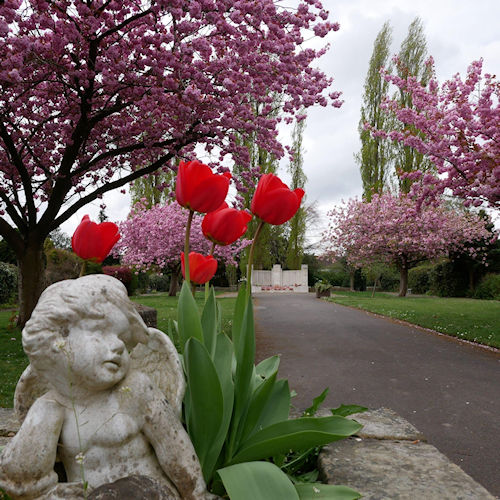
It transpired that Jean had visited the memorial garden where the communal war grave is located at London Road Cemetery on Remembrance Sunday that year, but could not find her father's name on the memorial so was not sure if he was buried there. She said "If I was to find his grave it would be as if part of me would be complete. I hope I will have the opportunity of saying goodbye to my father after all these years. At the moment there's that part always missing and when I was a child I always used to think he would turn up. I think I thought that for years but as you get older you realise that's not going to happen."
She went on to say that she had emigrated to Canada with her first husband in 1965 but sadly he had died six months later. He was buried there and their children were young at the time. They later visited Canada to see his grave and this had prompted her to visit the last resting place of her dad. She had often discussed visiting Coventry with her son and daughter-in-law so in 1998 they finally did. Jean also explained that her grandparents in Belfast (Robert and Jean Lambe) had died not too long after Billy when she was still young so hadn't been able to pass any details on, and that her mother Sadie did not really know too much about where he was buried. The article ended with an appeal for anyone who had further information to contact her.
A follow up article appeared in March 1999 which showed a smiling Jean pointing to her dad's name on the Coventry Police Roll of Honour. It said that the Police had also presented her with a copy of it and gave her other documents relating to Billy. She said she was delighted with the response to her appeal and was particularly grateful to Coventry Police. The next step for her was to get Billy's name engraved on the memorial at London Road Cemetery. As you can see from the photograph at the beginning of this article, she was successful. Billy is also remembered on the West Midlands Police Roll of Honour in Birmingham and at the Coventry Police Museum.
Hopefully this article now adds to those tributes - thank you from the people of Coventry for your bravery and selflessness, Billy.
Website by Rob Orland © 2002 to 2025